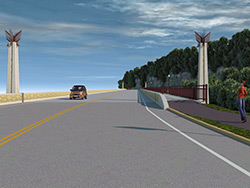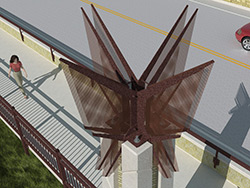Because of the proximity of the bridge to scenic Bellevue State Park, the Iowa DNR expressed concerns about the appearance of the new bridge and roadway barriers that would flank the park's entrance. During discussions with park officials and representatives of the city of Bellevue in the planning stages of the project, it became clear that the design of the structure should be sensitive to the site's natural surroundings and multiple viewing opportunities. The replacement of the current bridge would also be a chance to create an artistic statement that both complements the environment and celebrates its task of carrying the GRR through such a beautiful setting.
 Inspiration for bridge features came directly from the limestone bluffs that rise above the south end of the site. In a typical scenario with this type of dominant physical context, a designer might simply make the bridge's concrete surfaces appear to be made from blocks of the local stone by using form liners that mold concrete to look like stone walls. Rather than build yet another bridge of this kind, the designers asked a question: Instead of making it appear to be MADE of stone, what would the bridge look like if it actually WERE the stone?
Inspiration for bridge features came directly from the limestone bluffs that rise above the south end of the site. In a typical scenario with this type of dominant physical context, a designer might simply make the bridge's concrete surfaces appear to be made from blocks of the local stone by using form liners that mold concrete to look like stone walls. Rather than build yet another bridge of this kind, the designers asked a question: Instead of making it appear to be MADE of stone, what would the bridge look like if it actually WERE the stone?
The quest to define this abstract notion became a driving force that helped to determine the form and finish of the bridge's piers, traffic barriers, abutments, and towers. Flat — and normally featureless — concrete surfaces exhibit erratic rustications, like fractures in weathered rock. Deep fissures run the height of the monolithic pier columns, exposing rock-like strata within. Multiple form liners were used in unconventional ways to create variegated layers of stone textures, as if laid down by natural geologic processes. The bridge's abutments appear as limestone outcroppings projecting from the landscape. There are even scree piles of broken limestone at the base of pier columns to suggest debris resulting from natural erosion.
 The bridge's superstructure is constructed of naturally weathering steel, which gains a protective, rich red-brown patina from exposure to the elements over time. The same material is used for the pedestrian railings, which will help the bridge to blend with the scenic natural setting, and lends color to the railings without the maintenance concerns that a painted railing would have suffered.
The bridge's superstructure is constructed of naturally weathering steel, which gains a protective, rich red-brown patina from exposure to the elements over time. The same material is used for the pedestrian railings, which will help the bridge to blend with the scenic natural setting, and lends color to the railings without the maintenance concerns that a painted railing would have suffered.
The crowning feature of the bridge was inspired by a special place within nearby Bellevue State Park — the "Garden Sanctuary for Butterflies," a unique area with flowers and other plantings especially chosen to provide food and habitat for many different species of butterflies. The paired towers at the ends of the bridge each have four abstract weathering steel butterflies perched atop them, like a gathering of butterflies themselves appearing much like a flower. Their wings are made of perforated steel, which will make them appear to shimmer when viewed by motorists while they cross this new addition to their journey along the GRR.
Return to the Featured Bridges page.